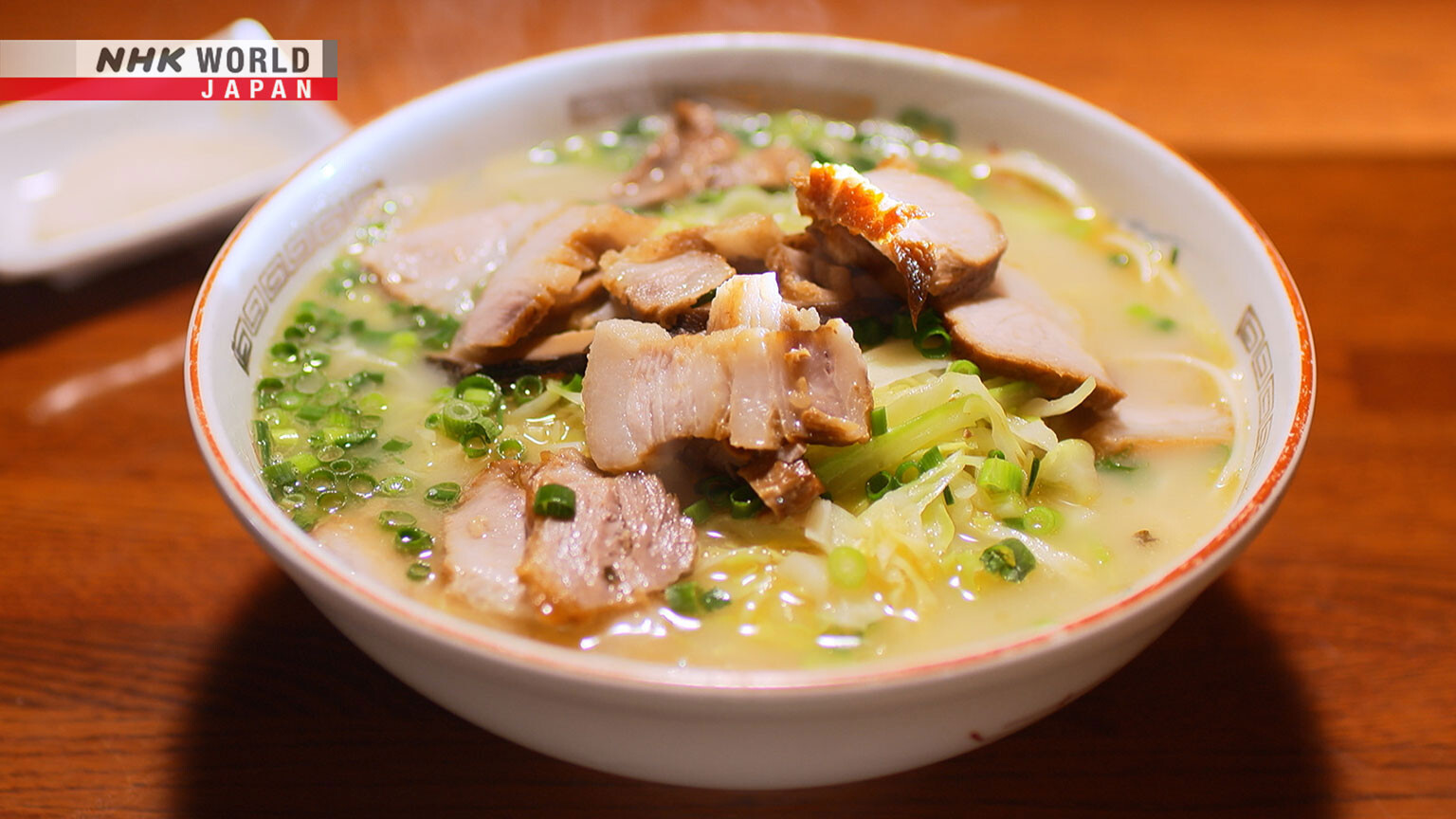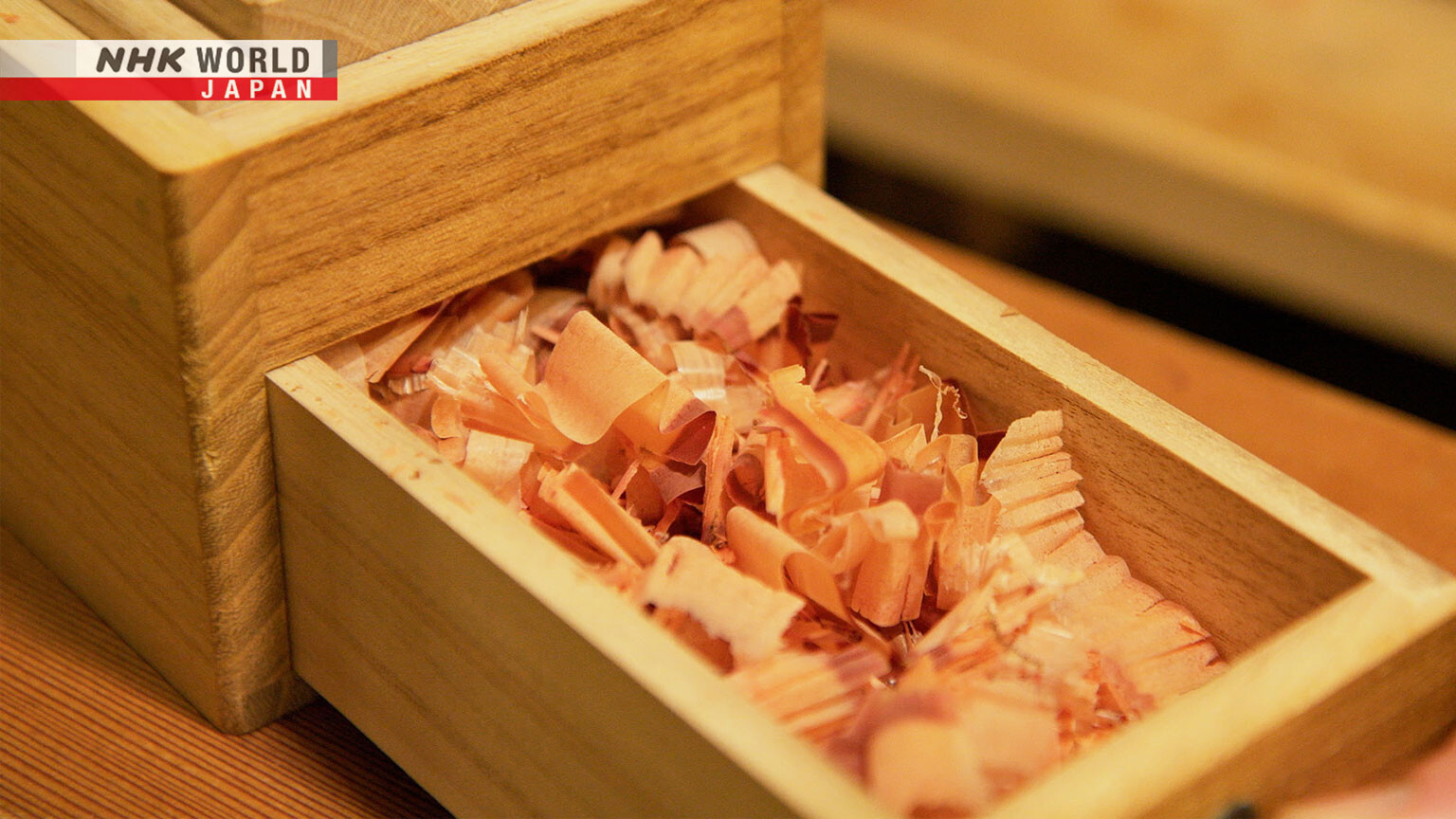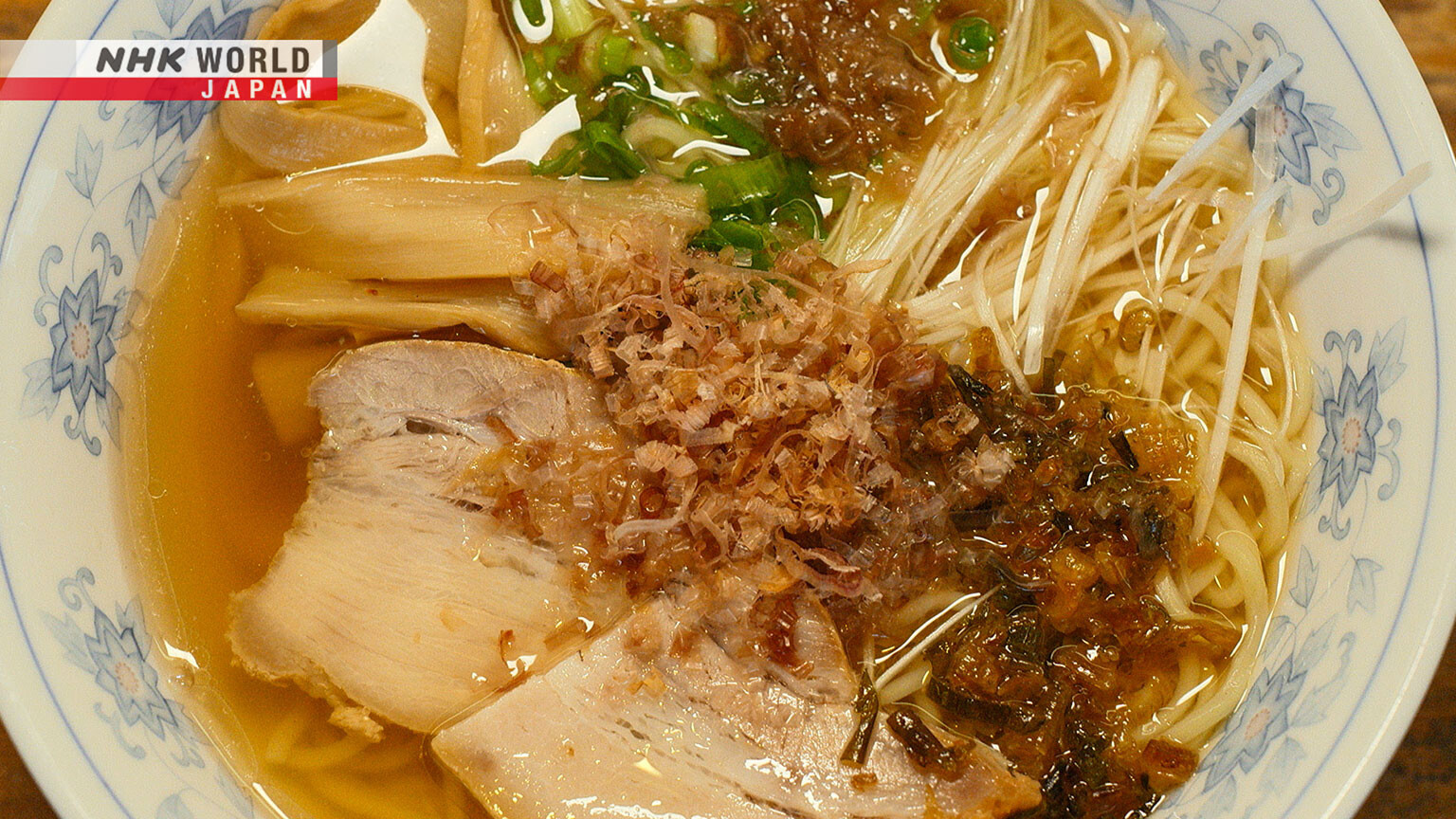KAGOSHIMA
Embark on a flavorful journey through Kagoshima Prefecture's diverse ramen, a distinct evolution within Kyushu's tonkotsu realm!




Transcript
Ramen Japan! This time, we're in Kagoshima.
Here in the south of Japan, there is a unique ramen culture unlike any other.
Welcome to Japan, the land of ramen!
Kyushu is an intense battleground for "tonkotsu" ramen, which has a broth derived from pork bones.
And Kagoshima ranks near the top for the number of ramen shops per capita.
When it comes to Kagoshima ramen, there's a legendary shop said to have started it all.
Noboru Ramen.
Noboru-ya, in Nakamachi.
It was always like, let's go to Noboru's.
It's quite well-known. Like a household name.
Established in 1947,
it claims the proud distinction of being the first ramen shop in Kagoshima.
It was quite light. Perfect to cap off a night.
Classic Kagoshima Berkshire pork "chashu" on top, and delicious soup.
The shop's legendary founder, Michioka Tsuna.
Working as a nurse during the war, a patient from China taught her a recipe for ramen,
and the rest is history.
A man who knew Michioka and her ramen.
Born and raised in Kagoshima, Sakaguchi Shunei is editor-in-chief of a town magazine.
You'd go in, and they'd say, "Here's some tea and pickles."
Waiting for the noodles was enjoyable. You'd chat and nibble on pickles.
When leaving, they'd give you a small mandarin orange from Sakurajima.
It was quite a warm and welcoming atmosphere.
After the shop closed its doors, it made a miraculous comeback.
United by a desire to savor it once more, its regular customers rallied together.
The legendary shop's ramen eventually made its way across Kagoshima city.
This one was established in 1963.
The interior of the shop, the menu, the cooking process, the ingredients.
And of course, the taste has stayed the same ever since its establishment.
On this day, too, the small shop is filled with regulars.
Last time we came it was closed, so we made a trip for a revenge visit.
It was so good!
It's so delicious, I can eat two bowls.
The broth is rich yet light.
Other shops can't even come close to the soup's flavor here.
I'll never go anywhere else.
Our loyal customers keep coming and encouraging us not to quit.
We're happy to hear that the taste they loved from childhood hasn't changed.
Next, we visited here.
This shop's ramen is characterized by a slightly unusual method
that has been used since its founding.
First, a special sauce and noodles are combined, then vegetables and "chashu" are added on top,
and finally, pork bone soup is poured over it.
To ensure the flavors combine properly, the ironclad rule is to mix it well before eating.
For regulars, mixing it before they start eating has become like second nature.
This has been the shop's unchanged style since its founding in 1952.
We were just here the other day.
The ramen here is a real treat. Being so affordable, it helps us out.
It's been around for so long. I was in high school back then.
Now I'm a grandmother.
It's a taste I've known and loved for a long time.
We load up the vegetables.
My father used to run a greengrocer pre-war.
He wanted customers to feel satisfied by eating a lot of veggies.
Next, we visited a shop smack dab in the middle
of Kagoshima city's bustling downtown area, founded in 1950.
Their signature bowl features shredded cabbage piled so high that it hides the noodles.
And if that wasn't enough, a generous serving of "shiitake" mushrooms
and Berkshire black pork "chashu" makes for a very hearty bowl.
According to third-generation owner, Hashiguchi Hideaki, originally it started as an "udon" noodle shop.
After the war, they weren't sure what to do.
It was clearly the era for ramen and his grandfather stepped up eagerly.
He was an official in Taiwan and not really a cook by trade.
But he made ramen at home based on his mom's ramen.
This truly unique bowl has a devoted local following.
I've been coming here for 45 years, and the taste hasn't changed.
There's just so much cabbage and vegetable goodness.
The way they intermingle with the noodles makes for a very tasty bowl.
Whenever I come to Kagoshima, this is my go-to ramen shop.
It's so good.
We've been going 74 years with just this style.
They've asked us to do miso ramen or other flavors, but I refuse.
At first glance, these shops may seem to have not much in common besides their pork bone broth base.
But served alongside each bowl, 'pickles.'
Not to mention, the unchanging spirit of hospitality.
For locals, the familiar taste of their favorite shop is what Kagoshima ramen is all about.
In Japanese cuisine, there are various dishes that showcase the rich flavors of a good broth,
as well as seasonal vegetables, and the natural flavor of ingredients.
An essential ingredient in many of these Japanese dishes is "katsuobushi,"
which is made by aging and drying bonito.
Thinly shaving flakes of "katsuobushi," and combining it with kelp for example, creates a broth.
The "umami" containing components of this broth are crucial.
Broth forms the foundation for Japanese cuisine.
It's absolutely vital.
If we ran out of "katsuobushi," it would be shocking.
Boasting 50% of the nation's entire production of "katsuobushi," is Kagoshima's Makurazaki.
With a high volume of bonito catches,
this number-one "katsuobushi" city in Japan has its own distinct ramen.
"Katsuobushi" is made by filleting and thoroughly drying the flesh of bonito.
On top of this, a special mold that produces the "umami" flavor is grown and aged.
It takes up to four months for a single piece of "katsuobushi" to be completed.
Craftsman Agemura Hakuro takes pride in Makurazaki's "katsuobushi."
You have to make something worthy of trust.
That's what we do in Makurazaki.
It's about maintaining the time-honored deliciousness.
The kind that earns respect because it takes time and effort to make.
To savor Makurazaki bonito flakes,
the first place we visited was a Japanese restaurant in the town center.
They specialize in bonito dishes.
A popular choice is their bonito ramen.
This bowl features a broth made with bonito flakes,
and astonishingly topped with bonito sashimi and tempura.
About 20 years ago, we served regional cuisine like seared bonito sets.
But then we decided to create a new local specialty.
We wanted it to be on the same level as a proper ramen shop.
We experimented with marinated sashimi, tempura, and more.
It took a lot of trial and error, but we finally succeeded.
I found myself in Makurazaki, so I gave it a try.
There was no unpleasant fish smell. It went down so easy.
Next, late in the evening, we visited this bustling and lively shop.
It's "izakaya" like atmosphere welcomes locals every night -
and it's a bona fide ramen shop.
There's a particular bowl which the regulars invariably order as their closer.
And that's this ramen here.
With an almost unbelievably lavish amount of Makurazaki bonito flakes,
this bowl is a bonito broth "umami" extravaganza.
"Katsuobushi" bonito is our local lifeblood. It's packed with "umami."
I think the difference is in the aroma.
The taste can be imitated but the essence is irreplaceable.
It's light, so even after drinking, it went down smoothly.
It was delicious, like ramen that's rich with the flavor of Japanese broth.
In fact, there's a special way of eating it that the regulars swear by.
The ramen itself is delicious of course.
But adding rice and more bonito afterward makes it even tastier.
I'm watching my weight, so I only eat this once every four days.
Ramen that's deeply rooted in and loved by the local communities.
Though their appearance and flavors differ, they all resonate with the people of Kagoshima.
The deep world of Kagoshima ramen goes far beyond any single bowl.
Come pay a visit for the best bowl of ramen you've ever had.